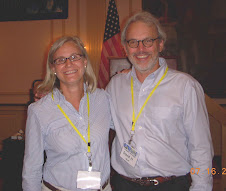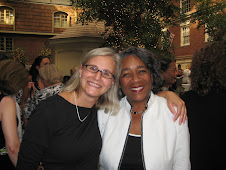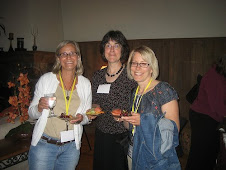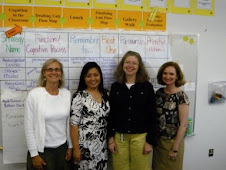Wednesday, December 19, 2007
Theory of Cognition Course
Students in Theory of Cognition are sophomores who want to accelerate their skills in order to be successful in IB classes as juniors and seniors. Rose and Mary are keeping with the NUA philosophy of "Do not remediate kids--accelerate them."
Rose and Mary have extensive NUA and Thinking Maps training, so this pre-IB course will involve the explicit instruction of thinking skills and concentrate on the metacognitive processes involved in reading, writing and math.
The ultimate goal for the students will be for them to see a problem and be able to tell themselves: "These are the thinking skills that I can use to solve this problem." In other words, the teachers will help the students to learn how to "mediate their thinking for self-directed learning."
Besides using Thinking Maps ad other written forms of metacognition, students in Theory of Cognition with employ Socratic dialogue. For example, students will use Socratic defense with math problems. If two students have different approaches to solving a math problem, each will defend his or her approach with reasons why.
Mary and Rose invite area teachers to observe their class and provide them with feedback. They can be reached at norris.mary@slpschools.org or korst.rose@slpschools.org.
Tuesday, December 18, 2007
Writing and Thinking
That statement equating thinking and writing started me on my quest to explore writing connections in the books that I had received from NUA. Although I had used or seen many of the strategies modeled, I had not scanned the books with a "writing and thinking" lens. I got some great ideas that I could pass on to teachers who had specific questions about teaching writing. Below is a summary of my findings:
Student Successes in Thinking Maps
Buckner's chapter in Student Successes in Thinking Maps called “Empowering Students from Thinking to Writing” specifically addresses how to help students write a non-plagiarized, authentic research paper. Buckner advocates the use of the tree map or flee map for note taking. English 10 teachers had great luck with the flee map last year during the research paper unit to help students organize their research findings before writing their paper.
In addition to tree or flee maps for note taking, Buckner states that teachers can help students with disorganized papers through a process of “reverse mapping.” Basically, students cut apart their paper and try to fit their sentences into a flee map. Reverse mapping also allows students to see any holes that they have in their paper.
Thinking Strategies for Student Achievement
Denise Nessel’s book, Thinking Strategies for Student Achievement, has a wealth of writing strategies. Here is the briefest of summaries of writing-relevant chapters:
Cubing (p. 39): Chapter 5 describes this strategy which allows students to think about a topic from multiple perspectives (describe, compare/contrast, associate, analyze, apply, and argue for/against). This strategy increases students' fluency on a topic and helps them learn the cognitive clues that are often used in essay questions.
Freewriting (p. 67): Chapter 9 discusses a long-time favorite strategy for English teachers that involves students writing for a sustained period of time without stopping. This technique is a great tool for generating ideas and overcoming writer's block.
I-Search Reporting (p. 81): Chapter 12 includes a number of follow-up questions that teachers can ask students to make research paper topics relevant to their lives by having students formulate questions that are related to their concerns and pursuits.
Imitation Writing (p. 87): Chapter 13 outlines this strategy which involves taking a known work or famous quotation and substituting words while maintaining the text's structure.
Journal and Learning Logs (p. 101): Chapter 15 includes a number of journal writing prompts not only for English teachers but also for math, social studies, and science logs.
Key Word Notes (p. 109): Chapter 16 details this strategy that many Edina teachers use for lectures, readings, films and classroom discussions. Key Word Notes is a quick and efficient information gathering strategy if students need to write an essay after a reading selection as part of an exam. To learn about more applications of this strategy, click on "Key Word Notes" under "NUA Topics Discussed on This Blog."
Paraphrasing (p. 141): Chapter 21 discusses how teachers should start students with paraphrasing of texts that students can’t copy—e.g. videos, the teacher reading aloud. Then students can progress to reading, putting down the text, and taking notes.
Saturation Reporting (p. 171): Chapter 27 discusses this eye witness written report based on intense observations of a certain location and/or event. These reports become detailed, sensory descriptions.
Writing Frames (p. 187): Chapter 30 of Nessel's book summarizes the strategy of using frames (text structures with blanks to be filled in) that is detailed in Writing as Learning by Andrew and Evelyn Rothstein.
Sample Descriptive Writing Lesson: On p. 171, Nessel outlines a writing lesson that incorporates a number of strategies previously mentioned in her book.
Thinking Maps: Tools for Learning
David Hyerle's Thinking Maps binder has many ideas for prewriting and essay organization. The "Teaching" section of the binder shows how each map can be used for prewriting an essay, and an essay prompt is included. Also, pages 3-17 and 3-24 have writing starter patterns.
If students learn cognitive clues in essay questions, they will be able to select the appropriate Thinking Map for organizing their ideas. For example, Thinking Maps are associated with the following expository text structures:
1) sequence is flow map
2) double bubble is compare and contrast
3) multi-flow is cause and effect
4) circle map or bubble map for describing
5) problem/solution involves multiple maps (circle map to define, double bubble to compare to possible solutions)
Writing as Learning
Andrew Rothstein, Evelyn Rothstein and Gerald Lauber's book Writing as Learning includes a number of strategies to assist with writing across the curriculum. The book discusses how the A to Z Taxonomy can be used both to engage students and to help them organize their ideas for writing. Chapter 7 "Profiles and Frames: Organize Your Writing" and Chapter 9 "Reasons, Causes, Results--The Basis of the Essay" appear to be the most relevant chapters to assist teachers with high school essay writing.
Monday, December 17, 2007
Circle Map in Elementary Science

Thursday, December 13, 2007
Instructional Flow Map
The boxes of the instructional flow map follow this order:
- Introduction
- Concept Development
- Vocabulary Development
- Skill Development
- Teach The Lesson (Guided Practice)
- Mediate for Mastery
- Teacher (self) Reflection
- Release the Lesson (Independent Practice)
- Review
- Student Reflection
- Concept Confirmation
- Assessment
Teaching the lesson does not occur until a lot of priming has happened for the students. In the introduction stage students need to be informed explicitly at the beginning of the lesson what are the goals, standards, strategies, and assessment for this lesson. Lately, I have been more careful telling students the what, why and how of each lesson, and specifically, I write the "explicit strategy instruction" on the board when students will be learning a new strategy.
Another priming observation that I had with the instructional flow map is that teachers need to front-load vocabulary. When Scott, the math coach, and I were discussing ways to introduce the ray, segment, and line unit for geometry students, we kept the instructional flow map in front of us so that we realized that the time taken for vocabulary development before teaching the lesson would be time well spent. So Scott planned to have students create a tree map or use defining format for the terms.
Next week before my World Literature students read "The Infant Prodigy" by Thomas Mann, I will spend a lot of time on vocabulary development before reading since the short story includes a number of musical terms that will be unknown to many students. During the vocabulary development stage of the instruction, I will employ the "Possible Sentences" strategy in Denise Nessel's Thinking Strategies book.
Another part of the instructional flow map that I felt has been neglected in my lessons in the past is the student reflection component. Stefanie pointed out that students need to be included in the equation when deciding if they are ready for the assessment. The day after Stefanie's instructional flow map presentation at Cornelia, I implemented this student reflection step by using the red light/green light approach that Stefanie had discussed.
The red light/green light strategy is simple yet effective. I gave students three cards--yellow, red and green--to keep on their tables as they prepared for a group fishbowl discussion on an assigned sonnet. If the group did not feel that they were ready to discuss their sonnet, they had the red card displayed. If they felt that they were close to being ready, they put out their yellow card. And if they were 100% ready to have their sonnet discussion assessed, they put out their green card.
My seniors were sceptical at first because they didn't understand why they couldn't just tell me when they were ready to present. I informed them that the visual display of cards around the room would allow other groups to also keep an eye on the progress of others, and if they noticed that many groups were going "Green," they would have to pick up their pace. The other benefit of the red light/green light strategy was that on-task time seemed to increase. As I circulated around the room, if I heard a group with a red card displayed talking about something unrelated to the assignment, I could flip their card to yellow, saying, "You must be close to being finished." I only had to do that to a few groups to keep everyone focused.
The instructional flow map has immediately impacted my curriculum design in the ways mentioned above, and I am sure that it will have an even greater impact as I use the tool even more.
Wednesday, December 5, 2007
Reading in Chemistry Foundations
In preparation for the sophomore state reading test, Chemistry Teachers Chad Nyberg, Dana Weiland and Mike Roddy used some NUA strategies in a lesson as part of the introduction to the heavy metals unit.
The lesson began with an anticipation guide listing statements that would be discovered in the readings that day. The lesson involved four articles for a group jigsaw, so a few statements were made from each reading. Upon reflection, however, the cumulative amount of statements was too large for the time allowed. Around five statements total would have proven sufficient to start the discussion of the impact of heavy metals on people's health.
After the students shared a few responses to anticipation guide statements, they formed groups of four, and each student read a different article. Two articles were on lead poisoning, and two were on mercury poisoning. As students read their assigned article, they completed a 4-Square writing that required the students to find three main ideas and supporting details for each main idea. The fourth square was where students recorded the author's purpose for writing the article. Although the fourth square is typically for a conclusion statement, we changed the box to purpose since we felt purpose was close to a student's final thoughts on an article and since the GRAD reading test often asks the question: What is the author's purpose.
After reading and writing about their articles, students shared the information with their groups, and then the groups re-visited their anticipation guides, discussing and correcting any of the statements.
The format for 4-Square Writing looks like this:







